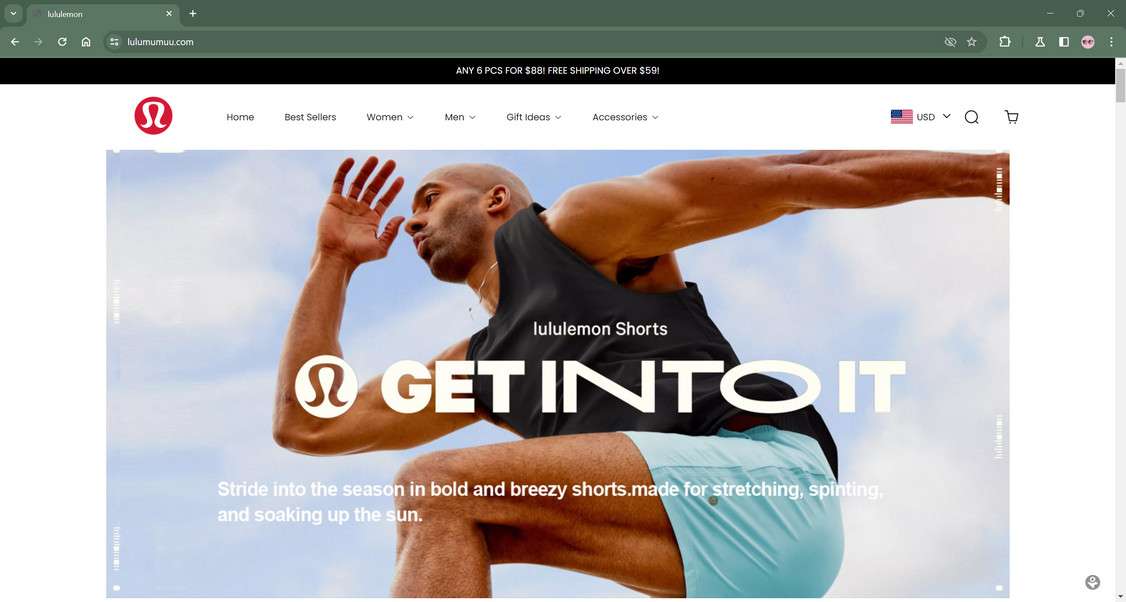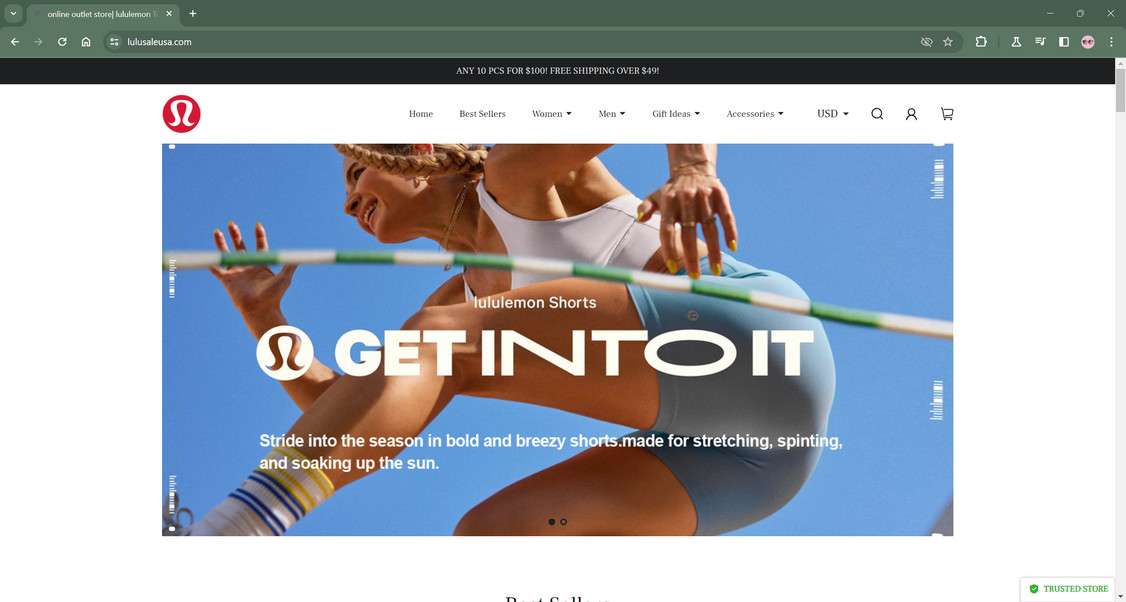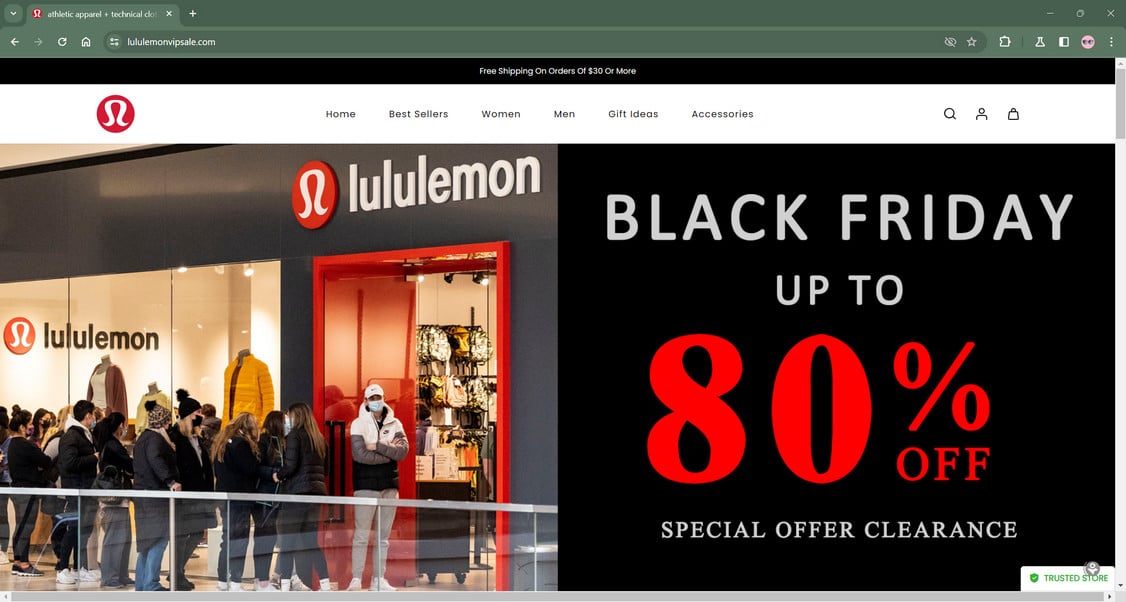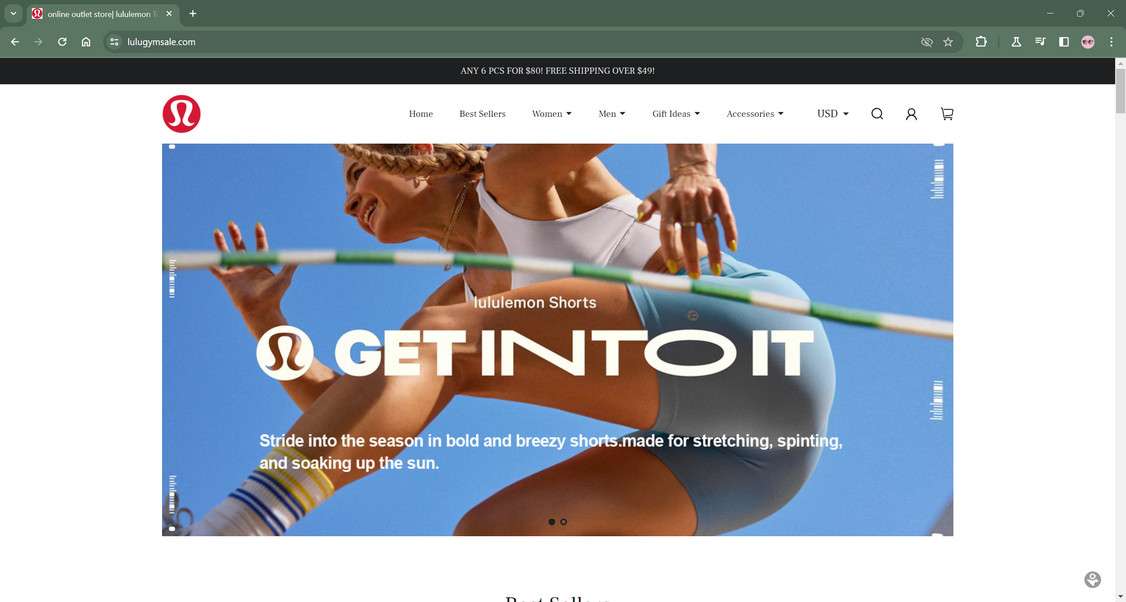A cunning clearance sale scam impersonating luxury activewear retailer Lululemon has emerged, heavily promoted through social media ads promising unbelievable discounts. However, behind the compelling posts hide fraudulent websites intentionally deceiving customers and stealing personal data and money. This article unravels how the elaborate ruse operates, protecting steps if victimized, and key signals exposing the frauds.




Overview of the Bogus Lululemon Promo Scam
In recent months, splashes of sponsored posts have saturated popular social platforms like Facebook, Instagram and TikTok boasting jaw-dropping Lululemon markdowns with sitewide discounts up to 90% off on yoga pants, leggings, sports bras and more.
The professional-grade ads employ precision targeting and tantalizing copy guaranteeing almost unbelievably low prices for the typically higher-end athletic apparel company. Taglines entice audiences with slogans like “Store Closing After 30 Years – Everything Must Go!” and “Today Only – Extra 50% Off Our Outlet Prices”.
However clicks reveal the unbelievable deals actually source from convincing yet utterly fraudulent websites falsely posing as authorized Lululemon partners. Enticed visitors soon find their money and personal information stolen by sophisticated criminal rings running international fake shopping scams through networks of highly convincing bogus websites.
Research ties these counterfeit operations back to notorious cybercrime hubs in China managing wide arrays of sham outlets mimicking Western brands. By scrapping real company assets then expertly reproducing authentic-looking webstores, scam networks manage to repeatedly bilk unsuspecting shoppers, especially deal-focused women aligned with Lululemon’s core yoga-loving demographic.
This overview explains why such extraordinarily discounted offers directly through social platforms should automatically raise suspicions. Learn how to protect yourself by scrutinizing vital signs exposing deceptive clearance sale scams lurking behind spectacular deals.
How the Slick Lululemon Social Scam Operates to Deceive Shoppers
The sophisticated retail scam operations utilize multiple strategies simultaneously that allow efficiently stealing consumer money and privacy. Highly-targeted social ads drive traffic onto fake web stores that appear legitimate, tricking visitors into relinquishing sensitive personal and financial information.
Step 1: Engineering Highly-Convincing Phony Lululemon Websites
The core infrastructure centers on reverse-engineering the authentic business website down to fine details. Every element gets painstakingly copied including imagery, branding, product selection and descriptions.
For unaware visitors, the imitated sites perfectly resemble the genuine shopping experience. Without noticing any initial alarming deficiencies, shoppers browse seasonal items and latest releases assuming valid association with the revered brand.
Yet no matter how refined appearances seem on the surface, the scam websites fundamentally lack legitimacy in selling actual goods or caring for customer satisfaction in the slightest.
Step 2: Promoting Links Through Social Media Trickery
The schemes rely entirely on attracting web traffic, so great efforts pour into crafting irresistibly appealing social advertisements promoting the fraudulent websites.
These compelling posts leverage core consumer psychology surrounding aspirational pricing and fear-of-missing-out on limited-time windfalls. Expertly doctored photos showcase the brand’s high-demand legging lines with overlays touting liquidation discounts up to 85% off the already expensive retail rates.
Rushing messages convey closing dates, final inventory and ticking timers to spike urgency dopamine hits further, especially among the brand’s core female demographic naturally drawn toward representing active lifestyles through premium athletic apparel.
Without considering potential underlying fraud, audiences eagerly click expecting to land on an authorized Lululemon outlet with blowout deals benefiting their budgets. But clicks lead instead straight into devious traps set by patient criminals ready to counterstrike.
Step 3: Stealing Identities, Payment Info and Destroying Trust
Upon entering sham Lululemon websites through social posts then hurriedly piling discounted products into carts, customers soon reach checkout phases. Here the true extortion pivots as visitors submit arrayed sensitive data including:
- Full legal names, home addresses and contact information
- Complete credit card or online payment account specifics
- Billing details including expiration dates and security codes
Victims willingly supply this information fully expecting fabulous deals on yoga essentials. Yet tragically, rather than marked-down athletic apparel, nearly all scammed shoppers are left utterly empty-handed as sneaky fraudsters pocket funds and vanish while dreams of fitness bargains disappear.
For especially unfortunate victims eventually receiving orders, the damage proves even worse through shoddy knockoffs or disturbing items like used women’s undergarments making clear no retailer would ever actually ship such revolting products to buyers.
Beyond just stealing submitted payment methods, all data entered including government ID numbers, dates-of-birth and contact profiles become ammunition for committing full-scale identity theft through various pathways:
- Draining bank accounts through credential abuse
- Opening illicit lines of credit under stolen names
- Selling info bundles on dark web marketplaces
By promoting unbelievable yet convincing clearance deals on coveted workout apparel to target demographics through social channels, sinister scam operations successfully manage large-scale thievery, privacy exploitation and brand reputation destruction.
Spotting Fraudulent Websites Promoting Bogus Lululemon Clearance Sales
While scam operations dedicate tremendous efforts making their duplicate Lululemon shopping websites appear realistically convincing to initial visitors, numerous subtle yet consistent signals across these fraudulent platforms empower eagle-eyed shoppers to evade surrendering sensitive personal data or payments to unbelievable price cut promotions.
Carefully analyzing website components along with rationally questioning legitimacy of steep discounts allows online consumers to sidestep potential identity theft traps while seeking deals on activewear essentials.
Auditing Domain Histories and Registration Timelines
Responsible retailers build branded online domains intending lengthy lifespans serving customers over years. Hastily registered sites strongly indicate temporarily sham operations looking to capitalize on clearance trends before discoveries.
- Fake sites often use domain names that sound convincingly similar to real brands, like “LululemenOutlet” or “LululemonSalesStore” rather than authentic URLs.
- Also check if sites created very recently within past 1-6 months and use masked Whois ownership records which suggest illegal scam fronts erected overnight.
Authentication of Advertised Discounts
Reputable brands occasionally offer sales seeking liquidity from inventory overstocks or when launching new product lines. However, savvy shoppers should view entire website clearance offers beyond 50-75% discounts with reasoned skepticism, especially sans explanations.
Moreover, legitimate limited-time promotions simultaneously highlighted across multiple official advertising channels including social media profiles, home webpages, direct mailers and email listings.
Thus always double-check deals promoted exclusively through third party ads but omitting references on brands’ primary e-commerce stores which signal likely bait claims without consistency.
Assessing Company Digital Footprints
Unlike short-lived scam websites relying purely on mimicking visual appearances of trusted retailers through stolen branding assets, legitimate corporations dedicate tremendous efforts building robust multimedia presences highlighting positive sentiments earned from years serving satisfied customers across various platforms.
Thus search rigorously for independent third-party communities, reviews and discourse affirming high credibility through lived experiences beyond purely paid advertising. Lack of such artifacts reasonably builds wariness over business authenticity.
Verifying Company Contact Information
A quick check on supposedly provided location details and communication channels reveals much behind curtained intentions. Easily contact live personnel willing to openly share corporate backgrounds like executive leadership bios, physical addresses and other fundamental organization descriptors reputable enterprises display prominently.
- Unanswered calls and emails bounced back due to invented contact details provide obvious red flags
- Organizations unwillingly sharing fundamental operational details outright signal sinister scams
With sharpened scrutiny across subtle but consistent patterns found on online clearance scams, informed shoppers can effectively expose disingenuous offers and fraudulent vendors seeking to trick eager visitors.
How to Spot Fraudulent Lululemon Social Media Ads
In tandem with engineering entirely fake ecommerce platforms mimicking authentic apparel retailers, clearance scam operations also harness sponsored social media advertisements to attract target audiences onto their fraudulent websites by promoting unbelievable yet convincing savings.
Highly deceptive sponsored posts explicitly showcasing too-good-to-be-true discounts frequently permeate Facebook feeds, Instagram stories and TikTok streams with aims of deceiving yoga enthusiasts and activewear shoppers. However, certain patterns across these advertisements expose their underlying deceitful intentions.
Spotting the Fake Lululemon Ads on Facebook
As the most expansive social media ecosystem allowing extensively tailored advertising capabilities, cunning Facebook scammers easily identify and target users displaying strong signals suggesting increased susceptibility towards taking promotional bait.
Some common traits helping distinguish sham Lululemon Facebook ads include:
- Exceptionally reduced prices like “Entire Inventory 90% Off Plus Free Shipping!” trying to spark intense fear-of-missing-out urgency
- Usage of time pressure messaging like “Final Hours! Lowest Prices Ever!” that also preys upon buyer tendencies to impulsively jump on perceived scarce opportunities
- Abundance of obscure shortened links that purposely route through multiple redirects in attempts to hide final landing site destinations
- URLs of landing pages failing to contain actual company names, trademarks or branding, often featuring unrelated themes like “fabshops” or “fitleggingdeals”
- Repeated changes across ad account names once accumulating user reports cause platform bans or account suspensions
In summary, savvy Facebook users gain enhanced abilities identifying fraudulent ads by honing in on emotional triggers, misleading links and occasional account churn patterns.
Spotting Fraudulent Instagram Ads
Successfully scamming Instagram feeds requires appeals blatantly through visual splendor showcasing beloved brands. But critical observers can still expose underlying deceptions:
- Abundance of generic lifestyle stock images hinting at inability legally using brand intellectual property, unlike authentic collaborations displaying real products
- Targeting strategies intensely focused on users fitting key yogi and female fashionista demographics
- Video clips relying on spliced footage from brand partners then edited with deceitful captions and artificial urgency soundtracks
- Accounts repeatedly modifying handles once disabled to sustain scam crusades under constantly resurrected identities
Effectively, awareness surrounding the immense difficulties scam operators face gaining legal branding permissions can help identify signs of trademark infringements.
Identifying Fake TikTok Ads
As TikTok rapidly emerges as a breakout force reshaping ecommerce through video-powered storefronts and influencer marketing, clearance scam rings attempt desperately to pivot operations towards exploiting the viral app for their profit models.
However, challenges plaguing scam TikTok ads include:
- Inabilities legally utilizing iconic brand assets without attracting swift copyright penalties
- Complications establishing lasting presences before inevitable account bans for policy violations
- Technical limitations producing high-grade sales videos matching the platform’s high expectations
Still while representative fraudulent Lululemon ads remain comparatively limited on TikTok currently, expecting rapid adaptations across criminal innovation labs means maintaining attentiveness for even subtle red flags signalling shady behavior, especially warning signs like:
- Low-quality content with giveaway technical glitches hinting at rushed overseas editing shops
- Awkward sales pitch dialogue that seems obviously scripted or presented deceptively
- Account histories only dating back days or weeks at most before removals and re-creations
Ultimately through heightened awareness surrounding precise psychological and technical tactics clearance scammers deploy across leading social networks, informed users and sharper personal insights can better spotlight deceitful retail cons in action.
What To Do If You Get Scammed By Fake Lululemon Sites
For victims unfortunately duped by fraudulent Lululemon discounts blasted through social media channels, promptly take these steps to halt further damages from stolen identities, payment data and assets:
Step 1: Contact Banks and Monitoring Services
Immediately call every credit and banking provider used at fake websites to report identity theft and unusual account activity. Freeze accounts, and enroll in dark web monitoring to track stolen info. Check statements vigilantly in upcoming months for unfamiliar charges.
Step 2: File Reports on All Aspects of the Scam
Submit detailed scam complaints conveying your experience to public agencies like BBB, FTC, and IC3 to ensure formal documentation when disputing damages later. Provide also copies to local police. Report impacted aspects including scam website URLs, domains, social media accounts promoting them and the overall fraud types.
Step 3: Closely Monitor Credit Reports
Carefully check credit reports from Equifax, Experian and TransUnion for unauthorized credit checks or accounts opened fraudulently using your identity. Consider services like LifeLock to enable instant alerts for all credit-related activities. Watch also for tax refund fraud from stolen SSNs. Remain vigilant across medical records also for identity theft signs.
Step 4: Attempt Reversing Fraudulent Transactions
Contact credit card providers and banks to report all scam charges as fraudulent right away. Demand they start dispute and chargeback processes immediately to try voiding payments. Provide maximum evidence showing the circumstances surrounding fraud. Monitor claim statuses closely demanding administrators reopen cases if initial reimbursement requests face rejection. Don’t hesitate seeking legal counsel for forcing restitution from uncooperative institutions enabling theft through mixups declining blatant scam cases.
While devastated emotionally and financially immediately after clearance sale scams, quick fraud intervention efforts combined with diligent long-term monitoring can mitigate damages and restore order after unfortunate encounters with cunning retail cons.
Frequently Asked Questions to Understand the Fake Lululemon Clearance Sale Scam
For savvy online shoppers questioning the curious case of too-good-to-be-true Lululemon deals permeating social feeds, this FAQ presents simplified responses surrounding the rampant athleisurewear scam and the cunning tactics used by fraudsters to trick yoga lovers.
What makes the bogus Lululemon promotions so deceptive online?
Skillful scam operators construct completely fake ecommerce stores flawlessly mirroring the real website down to intricately copying logo animations, product catalogs, and brand campaign designs to suspend visitor skepticism. Targeted ads drive traffic through optimized targeting filtering users by interest keywords including “yoga apparel deals”, “athleisure sales events”, and “activewear clearance blowouts”.
How exactly do the counterfeit websites mimic authentic branding?
Fakers digitally replicate real product images, videos, store layouts and copyrighted brand assets without authorization. Some even scrape full site data then rebuild functional mirrors that code authenticity checks get tricked into believing act as the genuine platform.
Why do scammers hype unbelievable discounts up to 90% off?
By promoting intentionally exaggerated yet still within reason clearance claims directly through advertisements seen by deal-seeking demographics, scammers intentionally trigger irrational urges to impulsively buy outpacing rational faculties. Seeing extreme yet still believable slash prices mentally justifies skipping vetting processes.
Do the scam stores actually sell any valid yoga gear at real discounts?
Absolutely not. All shown leggings, tops, shorts and other products simply comprise stolen images falsely depicting inventory. Beyond collecting payments and data at sham checkouts, zero legitimate merchandising or discounting capabilities exist since the entire presence constitutes a scam enterprise.
What repercussions typically happen after submitting data to counterfeits?
Most victims only experience payment theft as no goods ship while submitted details enter criminal data pools. In rarer cases, severely inadequate knockoffs arrive months later, used items ship, or completely random objects get sent to keep up appearances. But overall buyers face no positives, only loss.
Can customers get scammed without even placing any orders?
Yes. Merely accessing fake domains allows device infections from embedded malware installing through redirects, popups or downloaded files. Entering contact info like emails also flags victims for spam messages from broader fraud networks continually requesting more data.
How exactly do online retail scammers actually profit from stores selling nothing?
Direct profits come from stealing payments, financial information and identities collectable through bogus checkouts. Greater indirect gains flow from reselling data bundles on dark web marketplaces frequented by crime entities seeking profiles on buyers preferences and assets to craft targeted frauds.
Who organizes mass clearance shams impersonating globally iconic apparel brands?
Obscure cybercrime teams in fraud capitals like China specialize by mass counterfeiting entire online retail ecosystems to funnel assets indirectly back to ringleaders often concealed internationally to avoid capture. Impersonation targets shift as certain brands trend while technical and social engineering strategies constantly evolve to evade consumer defense tactics.
How long can these brand impersonation outlets succeed undetected typically?
Weeks or several months often pass before individual websites and advertising accounts get discovered and blacklisted. However persistent operators rotate site details, register new domains and launch rebuilt scams in recurring cycles continuously experimenting with novel techniques and becoming more evasive over time through adaptation.
Conclusion
In summary, highly-convincing clearance sale scams impersonating beloved athleticwear retailer Lululemon have emerged to target yoga-loving audiences across social channels using irresistible yet unbelievable deals promising once-in-lifetime savings. But behind these fraudulent promotions hide cynical criminal teams seeking only massive payouts through mass deception, identity theft and stripped consumer privacy.
By revealing the alarming scam tactics and equipping shoppers to scrutinize vital indicators exposing faked social advertisements and counterfeit websites, consumers can dodge traps set by exploitative transnational fraud networks. Remember that paying full retail prices proves better than forever losing hard-earned money or sensitive personal data by falling for creatively masked retail cons playing upon weaknesses for aspirational brand products at almost unbelievably economized costs. But with proper diligence assessing risks hiding cleverly behind such deals appeasing too perfectly, we can curb ambitious global shopping scammers across their tracks.










